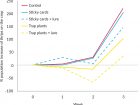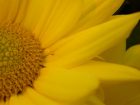
Features
Biocontrols
Inputs
How to Use Non-Crop Plants in Your Thrips IPM Programs
They’re versatile and include indicator plants, banker plants and everything in between
August 31, 2017 By Drs. Rose Buitenhuis and Michael Brownbridge
September 2017 – This is part 5 in a six-part series of articles on thrips (and other pests) integrated pest management, where we will provide practical application tips and tricks, information on new technologies and how it all fits within an overall IPM program. Each article will be accompanied by a short video demonstrating a technique or principle.
The content of this series is based on research performed at Vineland Research and Innovation Centre and is supplemented with “information from the field,” contributed by colleagues using biocontrol strategies in greenhouse production. For more information on specific biocontrol agents or IPM in general, see www.greenhouseIPM.org.
Plants can be great pest management tools. In previous instalments of this series, we have talked about the importance of the crop in IPM. In our figure about the important elements of IPM (see part 1, May 2017, pgs 24, 25, 26), this is the plant arrow.
First of all, it may be possible to grow more pest-resistant or disease-resistant varieties. Second, exciting research is now going on in greenhouse vegetables where microbes are used to induce resistance in plants.
In addition, production practices such as fertilizer or irrigation can make plants more or less susceptible. Therefore, understanding the relative susceptibility of different plant species and varieties to pests and diseases and the effects of production practices on the plants in your production system allows you to pre-plan a pest management program.
In this article we want to focus on the role of non-crop plants for pest and disease management. These plants are not grown to sell, but only to create an environment that is detrimental to pests and diseases and/or beneficial to biological control agents. In our previously mentioned figure, this would be the “environment” arrow. In other IPM definitions, this is often referred to as cultural control. There are different kinds of useful non-crop plants, also called companion plants, which we will describe in detail below.
Indicator plants are plant species or varieties that are more attractive to the pest than the main crop. Consequently, the target pest will show up on these plants first, providing an early warning system and (bio) control programs can be adjusted accordingly. As plants are the real deal for pests, providing visual, olfactory and gustatory stimuli, they are often more attractive and more specific than sticky cards.
Don’t get me wrong: sticky cards are still a useful tool for general monitoring of several pests, but if you want early warning about a specific pest, it is often better to use indicator plants.
Some common examples of indicator plants are beans for detection of two-spotted spider mites; flowering chrysanthemums for western flower thrips; and certain petunia varieties to monitor for tospoviruses transmitted by thrips, like Impatiens Necrotic Spot Virus (INSV) and Tomato Spotted Wilt Virus (TSWV). It is good to know that petunia will not be a source of new infections within the greenhouse. The viral lesion remains localized, so leaves can be picked off and infected plants do not have to be discarded.
The trap plant strategy is based on the same principle as indicator plants – their high attractiveness to pests – but now the goal is to catch a significant part of the pest population to prevent them from damaging the main crop.
The best known example in greenhouse crops is probably flowering chrysanthemums for mass trapping of western flower thrips (Figure 1). Mass trapping, either in the form of sticky cards, tape, or trap plants is a common sight in many commercial greenhouses worldwide. Although mass trapping by itself will not protect a crop, as part of an integrated pest management system it has proven very successful. Any thrips caught is one less to cause damage and prevents the production of up to 300 ‘baby-thrips.’
Mike MacLeod, production manager at Westbrook Greenhouses states: “ … in a few settings, we’ve found mass-trapping to be a critical tool in having success with thrips control.” You can read more about mass trapping with sticky tape or sticky cards in this article by Dr. Sarah Jandricic, Floriculture IPM Specialist with OMAFRA in the 2017 April issue of Greenhouse Canada.
So how do trap plants compare to sticky cards/tape for mass trapping of thrips?
Both are easy, inexpensive strategies to implement. Sticky cards are popular because they last a long time and do not have to be replaced often. Thrips get stuck permanently and will not go back into the crop. However, sticky cards may catch flying beneficial insects as well. Depending on how many biocontrol agents are trapped, this may have an effect on the efficacy of the biocontrol program.
In addition, as Judy Colley from Plant Products describes it: “Sticky traps are a hard sell because they are messy.” In other words, sticky cards/tape are equally good at catching humans as well as insects.
Korean researchers have shown that you can make sticky cards more effective by making them look more like flowers. Circular cards and cards with a dark background caught more thrips than plain square cards. Still, trap plants are probably more attractive to thrips than sticky cards/tape because they have everything a thrips could possibly dream of: many real flowers of the right colour, smell and taste (Figure 2).
The disadvantage of trap plants is that you have to replace them before they become a source of thrips instead of a sink, depending on the time of year this is every two to three weeks, or otherwise kill the thrips on the trap plants. They are definitely not something you can put in the greenhouse and forget about, but used properly, they will catch hundreds of thrips per plant.
This highlights a critical trait for a successful trap plant: once attracted to the plant, pests must remain on it. If the insects are attracted to the trap plant but ultimately leave to colonize adjacent crop plants, then their utility is marginal. In other words, simple attraction is not enough; retention on the trap crop is equally important. Use of supplemental strategies to prevent dispersal away from the trap crop enhances their effectiveness. In the previous example in chrysanthemums, plants are physically removed but in other agricultural crops, growers specifically apply pesticides to the trap crops. This limits pesticide use, and is more compatible with biocontrols than blanket-spraying an entire crop.
Yellow chrysanthemums are not the only plants you can use to trap thrips. Potted ornamentals with many flowers such as gerberas and marigolds are very attractive to thrips. Another option is cuban oregano (Plectranthus amboinicus), a non-flowering herb. Two researchers from Alberta, Olivia Hares and Dr. Kwesi Ampong-Nyarko discovered that this plant is highly attractive to thrips, but that the thrips do not establish on the plant. Instead, they are caught on a sticky card inserted in the plant. This means the trap plants do not have to be replaced as often as with, for example, chrysanthemums. Marco de Leonardis, R&D manager at Freeman Herbs, changed from flowering chrysanthemum trap plants to this system and is very happy with the results.
Most research has been done on trap plants for western flower thrips. It is very likely that attraction of other thrips species, such as onion thrips or echinothrips to these plants is different, especially because these pests are less attracted to flowers than western flower thrips.
Until now, mass trapping for thrips with trap plants or sticky cards/tape mostly catches thrips flying around in the greenhouse. Our previous research determined that once the thrips are on the crop plants, they are not very likely to move to trap plants. Instead, trap plants attracted a large proportion of dispersing thrips. Therefore, the current recommendation is to place trap plants at places where thrips are moving into the greenhouse, such as doorways and vents, close to hotspots, or in between different crops or crop stages to intercept thrips while they are dispersing.
Yet, wouldn’t it be nice if trap plants could act as vacuum cleaners, sucking thrips out of the crop? To test this, we did a trial at Vineland two years ago where we added thrips aggregation pheromone lures (Thripline, Bioline AgroSciences) to large blue sticky cards and yellow flowering chrysanthemum trap plants (var. Chesapeake) in a crop of non-flowering potted chrysanthemum. The pheromone lure causes thrips to aggregate on high, prominent objects, in our case … traps!
Figure 3 shows that trap plants with lures reduced thrips population growth the most compared to trap plants without lures and sticky cards with or without lures, and at Week 2 even reversed population increase in the crop. It would be interesting to see if other thrips attractants, like Lurem-TR (Koppert lure based on plant volatiles) and vanilla (recommended by Brian Spencer, Applied Bionomics) would have the same effect.
Research in the U.K. has shown that an isomer of Verbenone is highly attractive to western flower thrips. As the material is widely used in perfumes, it is significantly less expensive than most thrips pheromone analogues, meaning that the material could be economically used on a large scale to improve trap catches, or to enhance a push-pull strategy. Another potential option is investigated in Norway, where researchers use LED lights of an attractive colour next to sticky traps, but this research may also be applied to trap plants.
Trap plants are often used as part of a push-pull strategy. We discussed the “pull component” in the paragraphs above. Yet, are there ways to make the crop less attractive and “push” the thrips towards the trap plants? Some plant volatiles are known to repel insects and play a role in detection and acceptance of a host plant by a pest, or deter feeding or oviposition. Could cultivars producing these compounds be grown, or the trait bred into commercially important varieties to provide the “push” in this approach? Whether these effects also impact biocontrol agents and other beneficial species would also need to be understood, however, before deploying on a large scale in greenhouse crops.
As said before, trap plants are not a stand-alone method, they are part of an IPM system. Most of the time this means that other methods of controlling thrips are used as well, including releases of predatory mites or biopesticide sprays with nematodes or fungi.
Because trap plants will concentrate thrips in a restricted area, some growers use these areas as a focus for their biocontrol. For years, Boekestyn Greenhouses created trap plant islands using an attractive chrysanthemum cultivar (Vyron) and prioritized their releases of predatory mites on these islands where they controlled the thrips and dispersed from there into the rest of the crop. It worked well for several years, but with the introduction of predatory mite mini-sachets, they have switched to using one sachet per plant.
At the University of Vermont, Dr. Margaret Skinner developed a guardian plant system against thrips, where marigold plants are combined with a thrips pheromone lure to attract thrips, the predatory mite Neoseiulus cucumeris to control thrips larvae on the foliage of the guardian plant and BotaniGard mixed into the soil to control thrips pupae. The system is described in the 2014 March/April issue of Greenhouse Canada. In the absence of thrips, the predatory mites can feed on the pollen of the marigold plants and disperse into the crop.
This leads us to the next type of plants used as pest management tools, banker plants. Banker plants are non-crop plants that will provide supplemental food and/or oviposition sites for biological control agents. This helps them to establish in the greenhouse and to persist during periods of prey scarcity. The idea is to maintain a population of biocontrol agents that will be ready when pests arrive. Common examples of banker plants are wheat or barley plants infested with bird cherry oat aphids to maintain populations of the aphid parasitoid Aphidius colemani, mullein plants for the predatory bug Dicyphus hesperus and ornamental pepper plants to breed Orius insidiosus.
Orius is an excellent thrips predator, however it can be difficult to establish in the greenhouse in spring, and multiple releases are quite expensive. Growers have been looking at banker plants as a solution. Sweet pepper pollen is an excellent food source for Orius and this predatory bug likes to lay its eggs in the stems and leaf veins of this plant. However, growing full sized greenhouse sweet pepper as banker plants is just not practical in most greenhouse systems, especially in flower crops. Therefore, early Orius banker plant pioneers like Ronald Valentin (Bioline AgroSciences) turned to ornamental peppers. Meghann Waite tested several ornamental peppers and other flowering plants for their suitability as food and oviposition substrate for Orius during her MSc project at the University of Guelph and the Vineland Research and Innovation Centre. She found that Orius populations were highest on Purple Flash ornamental peppers.
Commercial greenhouse trials revealed the importance of pepper flowers to Orius; predator populations were directly correlated to the number of flowers on the banker plant. We also found that warmer temperatures (above 18 C) and supplemental food (Ephestia eggs) could boost the development of Orius populations on the banker plants. Ronald Valentin recommends that you start peppers in November and inoculate with Orius in February, to be ready for spring. In addition, growing the peppers in an area with supplemental light will make it possible to establish the Orius on the plants earlier.
Another Orius banker plant that growers use is alyssum. Judy Colley recommends these plants because they are easier to grow than ornamental peppers. She also observed that alyssum plants are less susceptible to pests.
Both peppers and alyssum are used in greenhouses where thrips are a problem throughout the spring and summer, such as spring crops followed by chrysanthemums or cyclamen. Several cucumber growers also hang a row of banker plants among their crop. It is probably a good system for strawberries, a crop increasingly grown in greenhouses, and we have even seen Orius banker plants used outdoors in June- and ever-bearing strawberries.
Companion plants, from indicator to banker plants, do things that the crop cannot do. From signalling problems to breeding biological control agents, there is a plant for that. It is up to us to take them to build a functioning ecosystem in the greenhouse.
Many thanks to the growers and consultants who provided the “real life” perspective to this article.
The studies by the authors described in this article were supported in part by Growing Forward 2 (GF2), a federal-provincial-territorial agricultural funding framework. The Agricultural Adaptation Council assists in the delivery of GF2 in Ontario. Funding support was also provided through Agriculture and Agri-Food Canada’s Agri-Innovation Program: Industry-led Research and Development Stream, Syngenta Bioline (now Bioline AgroSciences), OMAFRA-University of Guelph Research Program and Flowers Canada (Ontario).
We appreciate your feedback – Rose.Buitenhuis@vinelandresearch.com; Michael.Brownbridge@vinelandresearch.com.
Print this page


